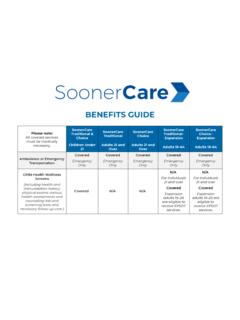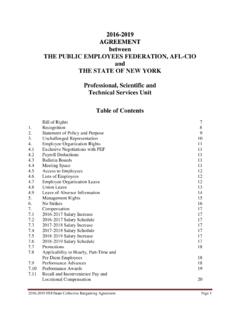Transcription of Medicare & Medicaid Milestones, 1937 to 2015, July 2015
1 Medicare & MedicaidMILESTONES1937-2015 July 2015 July 2015 Medicare & Medicaid Milestones Surgeon General Thomas Parran proposed that National Health Insurance first cover Social Security Federal Security Agency was created to administer federal organizations dealing with health, education and social insurance, including the Social Security Board, Public Health Service, and Office of the Social Security Board called for beneficiary health insurance, President Harry Truman publicly lent his support to National Health Insurance. 1960 s1965 Medicare and Medicaid were enacted as Title XVIII and Title XIX of the Social Security Act, providing hospital, post-hospital extended care, and home health coverage to almost all Americans aged 65 or older ( , those receiving retirement benefits from Social Security or the Railroad Retirement Board), and providing states with the option of receiving federal funding for providing health care services to low-income children, their caretaker relatives, the blind, and individuals with disabilities.
2 At the time, seniors were the population group most likely to be living in poverty; about half had health insurance coverage . To implement the Health Insurance for the Aged ( Medicare ) Act, the Social Security Administration (SSA) was reorganized and the Bureau of Health Insurance was established on July 30, 1965. This bureau was responsible for the development of health insurance policy. Medicaid was part of the Social Rehabilitation Service (SRS) at this Medicare was implemented and more than 19 million individuals enrolled by July Early and Periodic Screening, Diagnosis, and Treatment (EPSDT) comprehensive health services benefit was established for all children getting Medicaid . Medicare was also given authority to conduct demonstration projects. July 2015 Medicare & Medicaid Milestones 31970 s1972 Medicare eligibility was extended to individuals under age 65 with long-term disabilities and to individuals with end-stage renal disease (ESRD). Medicare was given additional authority to conduct demonstration programs.
3 Medicaid eligibility for elderly, blind and disabled residents of a state was linked to eligibility for the newly enacted Federal Supplemental Security Income (SSI) program. 1973 The HMO Act provided start-up grants and loans for the development of health maintenance organizations (HMOs). HMOs meeting federal standards relating to comprehensive benefits and quality were established and under certain circumstances had the right to require an employer to offer coverage to employees. The Medicare statute was also amended to provide for HMOs to contract to provide Medicare benefits to beneficiaries who choose to Health Care Financing Administration (HCFA) was established to administer the Medicare and Medicaid programs. 1980 s1980 coverage of Medicare home health services was broadened. Medicare supplemental insurance, also called Medigap, was brought under federal of choice waivers and home and community-based care waivers were established in Medicaid . States were required to provide additional payments to hospitals treating a disproportionate share of low-income patients (called disproportionate share hospitals, or DSH).
4 1982 The Tax Equity and Fiscal Responsibility Act made it easier and more attractive for health maintenance organizations to contract with the Medicare program providing for Medicare payments on a full risk basis. In addition, the Act expanded the Agency s quality oversight efforts through Peer Review Organizations (PROs). July 2015 Medicare & Medicaid Milestones 41983 An inpatient acute care hospital prospective payment system for the Medicare program, based on patients diagnoses, was adopted to replace cost-based payments. The Medicare hospice benefit was established as an option for beneficiaries to receive all-inclusive care to relieve pain and manage symptoms in a home setting rather than an institutional setting. 1986 The Emergency Medical Treatment and Labor Act (EMTALA) required hospitals participating in Medicare that offer emergency services to provide appropriate medical screenings and stabilizing treatments. Medicaid coverage for pregnant women and infants (up to 1 year of age) up to 100% of the Federal Poverty Level (FPL) was established as a state The Omnibus Budget Reconciliation Act of 1987 (OBRA 1987) strengthened the protections for residents of nursing Medicare Catastrophic coverage Act of 1988 was enacted, which included the most significant changes since enactment of the Medicare program, improved hospital and skilled nursing facility benefits, covered mammography, and included an outpatient prescription drug benefit and a cap on patient Medicare Catastrophic coverage Act also provided for Medicaid coverage for pregnant women and infants up to 100% of the FPL was mandated; special eligibility rules were established for institutionalized persons whose spouses remained in the community to prevent spousal impoverishment.
5 The Qualified Medicare Beneficiary (QMB) program was established to pay Medicare premiums and cost-sharing charges for beneficiaries with incomes and resources below established thresholds. The Clinical Laboratory Improvement Amendments (CLIA) of 1988 strengthened quality performance requirements for clinical laboratories to ensure accurate and reliable laboratory tests and procedures. 1989 The Medicare drug benefit and other enhancements of Medicare coverage in the Medicare Catastrophic coverage Act of 1988 were repealed after higher-income seniors protested new premiums. A new Medicare fee schedule for physician and other professional services, a resource-based relative value scale, replaced charge-based 2015 Medicare & Medicaid Milestones 5 Medicaid coverage of pregnant women and children under age 6 up to 133% of the FPL was mandated; expanded Early and Periodic Screening, Diagnostic and Treatment (EPSDT) requirements were s1990 Phased-in Medicaid coverage of children ages 6 through 18 under 100% of the FPL was established, and a Medicaid prescription drug rebate program was created.
6 A specified low-income Medicare beneficiary eligibility group (SLMBs) was also established for Medicaid programs to pay Medicare premiums for beneficiaries with incomes at least 100% but not more than 120% of the FPL and limited financial resources. Additional federal standards for Medicare supplemental insurancewere Disproportionate Share Hospital (DSH) spending controls were established, and provider-specific taxes and donations to states were became independent of the Department of Health and Human Services (HHS). After occupying office space on the SSA campus and in other nearby buildings in Baltimore, HCFA consolidated into its own 960,000 square foot national headquarters down the road from SSA on Security Reform: The Aid to Families with Dependent Children (AFDC) entitlement program was replaced by the Temporary Assistance for Needy Families (TANF) block grant; the welfare link to Medicaid was severed; a new mandatory low-income group not linked to welfare was added to Medicaid ; and enrollment in/termination of Medicaid was no longer automatic with receipt of welfare cash Health Insurance Portability and Accountability Act of 1996 (HIPAA) was passed.
7 It had several provisions. First, it amended the Public Health Service Act, the Employee Retirement Income Security Act of 1974 (ERISA), and the Internal Revenue Code of 1986 to provide for new federal rules improving continuity or portability of coverage in the large group, small group and individual health insurance markets. HCFA implemented HIPAA provisions affecting the small group and individual markets. July 2015 Medicare & Medicaid Milestones 6 Second, it created the Medicare Integrity Program which dedicated funding to program integrity activities and allowed HCFA to competitively contract for program integrity work. Third, it created national administrative simplification standards for electronic health care transactions. Fourth, it required HHS to issue privacy regulations if Congress failed to enact substantive privacy Balanced Budget Act of 1997 (BBA): The Children s Health Insurance Program (CHIP) was created; limits on Medicaid payments to disproportionate share hospitals were revised; new Medicaid managed care options and requirements for states were established.
8 BBA also made changes to Medicare including: Establishing an array of new Medicare managed care and other private health plan choices for beneficiaries, offered through a coordinated open enrollment process. Expanding education and information to help beneficiaries make informed choices about their health care. Requiring HCFA to develop and implement five new prospective payment systems for Medicare services (for inpatient rehabilitation hospital or unit services, skilled nursing facility services, home health services, hospital outpatient department services, and outpatient rehabilitation services). Slowing the rate of growth in Medicare spending and extending the life of the trust fund for 10 years. Providing a broad range of beneficiary protections. Expanding preventive benefits. Testing other innovative approaches to payment and service delivery through research and demonstrations. 1998 The Internet site was launched to provide updated information about first annual Medicare & You handbook was mailed to all Medicare beneficiary households.
9 The toll-free number, 1-800- Medicare (1-800-633-4227), became available nationwide. July 2015 Medicare & Medicaid Milestones 7 The Ticket to Work and Work Incentives Improvements Act of 1999 (TWWIIA) expanded the availability of Medicare and Medicaid for certain disabled beneficiaries who return to work. The law established optional Medicaid eligibility groups and allowed states to offer a buy-in to Medicaid for working-age individuals with Balanced Budget Refinement Act of 1999 (BBRA) increased payments for some Medicare providers and increased the amount of Medicaid DSH funds available to hospitals in certain States and the District of Columbia. Other related legislation improved Medicaid coverage of certain women s health s2000 The Benefits Improvement and Protection Act (BIPA) further increased Medicare payments to providers and managed health care organizations, reduced certain Medicare beneficiary co-payments, and improved Medicare coverage of preventive services.
10 BIPA created a new Medicaid prospective payment system for Federally Qualified Health Centers and Rural Health Clinics (FQHCs/RHCs) and modified the amount of Medicaid DSH funds available to hospitals. It also delayed for one year the sunset of transitional medical assistance provided to families eligible for Tommy Thompson renamed the Health Care Financing Administration (HCFA) the Centers for Medicare & Medicaid Services (CMS).2003 The Medicare Prescription Drug, Improvement, and Modernization Act (MMA) made the most significant changes to Medicare since the program began. MMA created a new optional outpatient prescription drug benefit, effective in 2006, provided through private health plans allowing for competition among health plans to foster innovation and flexibility in coverage , covered new preventive benefits, and made numerous other changes. For the period prior to 2006, MMA created a temporary prescription discount card with incomes less than 150% of the FPL became eligible for subsidies under the new Part D prescription drug program.















